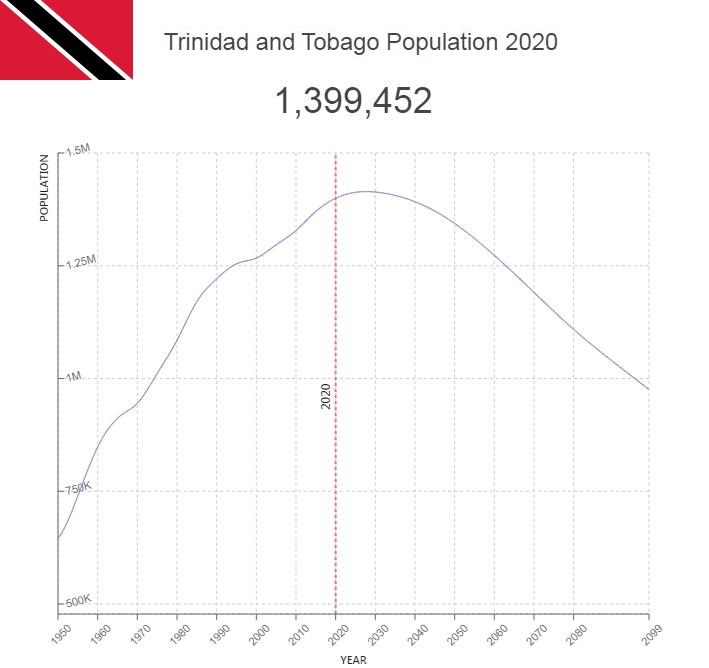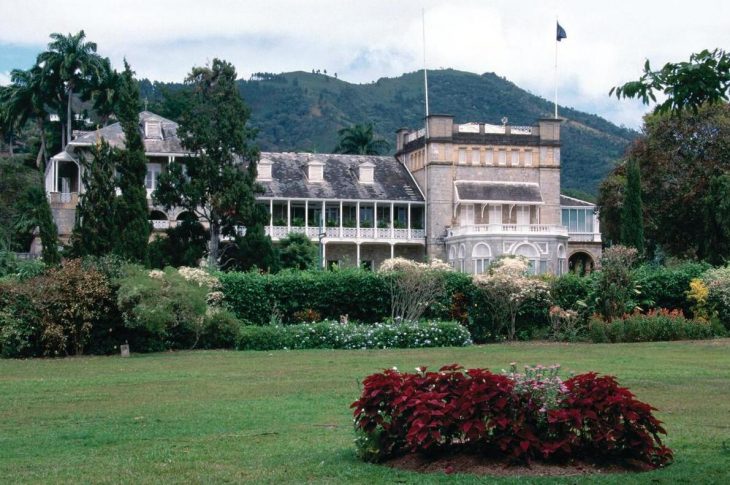Trinidad and Tobago Population

Trinidad and Tobago are the southernmost islands of the Lesser Antilles. The country is one of the richest and most industrialized in the Caribbean thanks to a large oil and gas industry.
Key figures and facts
- Capital: Port of Spain
- Ethnic groups: Indians 35.4%, African Chain 34.2%, Blend-Other 15.3%, Blend African-Indians 7.7%, Other/Unspecified 7.5% (2011)
- Language: English (official), Trinidadian Creole-English, Tobagic Creole-English, Caribbean Hindustani, Trinidadian Creole-French, Spanish, Chinese
- Religion: Protestants 32.1%, Catholics 21.6%, Hindus 18.2%, Muslims 5%, Jehovah’s Witnesses 1.5%, others 8.4%, none 2.2%, unspecified 11.1% (2011)
- Population: 1 372 598 (2018)
- Control Form: Republic
- Area: 5 130 km2
- Currency: Trinidad and Tobago Dollar
- GNP per capita: 32 855 PPP $
- National Day: August 31st
Trinidad and Tobago Population
In 2013, the population of Trinidad and Tobago was estimated to be 1341,000 residents (World Bank), and annual population growth to 0.3%. Natural growth (born ÷ dead) is higher, the birth and death rates for 2005 were 14 and 8 per thousand respectively. A negative balance of payments keeps growth down. Life expectancy is estimated to be 73 years for women and 67 years for men.

Trinidad’s indigenous people were Arawaker, a Native American people. Tobago was uninhabited in pre-Columbian times. The current population of the islands is very complex; About 60% of the population is of African origin, incidentally many of Indian origin. These are largely descendants of contract workers who came to the sugar plantations in Trinidad after the abolition of slavery in the first part of the 19th century.
About 96% of the population lives in Trinidad. 75% of the population lives in urban areas. Major cities are the capital Port of Spain and San Fernando.
Population of Trinidad and Tobago by Year (Historical)
| Year | Population | Annual Growth Rate | Population Density | Global Rank |
| 2020 | 1,399,377 | 0.320% | 272.8047 | 154 |
| 2019 | 1,394,862 | 0.370% | 271.9246 | 153 |
| 2018 | 1,389,732 | 0.420% | 270.9246 | 153 |
| 2017 | 1,383,948 | 0.470% | 269.7971 | 153 |
| 2016 | 1,377,449 | 0.530% | 268.5302 | 153 |
| 2015 | 1,370,217 | 0.630% | 267.1205 | 153 |
| 2010 | 1,328,036 | 0.480% | 258.8981 | 153 |
| 2005 | 1,296,391 | 0.460% | 252.7294 | 152 |
| 2000 | 1,267,042 | 0.210% | 247.0084 | 150 |
| 1995 | 1,254,089 | 0.540% | 244.4834 | 149 |
| 1990 | 1,221,005 | 0.850% | 238.0343 | 149 |
| 1985 | 1,170,174 | 1.530% | 228.1257 | 148 |
| 1980 | 1,084,633 | 1.420% | 211.4511 | 146 |
| 1975 | 1,010,825 | 1.350% | 197.0635 | 145 |
| 1970 | 945,249 | 0.730% | 184.2807 | 144 |
| 1965 | 911,626 | 1.460% | 177.7265 | 144 |
| 1960 | 847,868 | 2.770% | 165.2980 | 143 |
| 1955 | 739,598 | 2.760% | 144.1928 | 142 |
| 1950 | 645,524 | 0.000% | 125.8548 | 143 |
Major Cities in Trinidad and Tobago by Population
| Rank | City | Population |
| 1 | Chaguanas | 67,322 |
| 2 | Mon Repos | 56,269 |
| 3 | San Fernando | 55,308 |
| 4 | Port of Spain | 48,920 |
| 5 | Rio Claro | 35,539 |
| 6 | Arima | 34,889 |
| 7 | Marabella | 26,589 |
| 8 | Laventille | 20,889 |
| 9 | Point Fortin | 18,945 |
| 10 | Tunapuna | 17,647 |
| 11 | Scarborough | 16,889 |
| 12 | Sangre Grande | 15,857 |
| 13 | Paradise | 14,956 |
| 14 | Penal | 12,170 |
| 15 | Arouca | 11,943 |
| 16 | Princes Town | 9,889 |
| 17 | Siparia | 8,457 |
| 18 | Petit Valley | 8,029 |
| 19 | Couva | 5,067 |
Religion
The Christian population is approximately 60%, well half are Catholics. Protestant communities include Anglicans (about 11%), Pentecostal friends (7.5%), Presbyterians, Methodists, and Baptists. About 25% are Hindus and approximately 6% are Muslims.
Language
English is the official language. Widespread as a spoken language is Creole French, Spanish and Hindi.













































